Sizing Up the Bond Films: 38 Years of Excitement and Ridiculous Boredom
by Dan Heaton
The James Bond films are a cultural phenomenon. Five men have starred as James Bond (not including Casino Royale), and each has developed his own version of the role. While George Lazenby only played him for one film, definite differences exist between his personality and the Bond played by Sean Connery or Roger Moore. Timothy Dalton tried to move the character back towards its origins, and fans scoffed in droves. The recent Pierce Brosnan films drew huge crowds at the box office, and they contain a more crowd-pleasing variation of the Bond character. This current incarnation has very little in common with the original Ian Fleming creation, and mass audiences appear to want it that way. Still, the series lives on with certain tenets that appear in virtually every film. It is impossible to name them all, but I've created a short list of the usual Bond elements. Keep in mind that the year of the film's release and the actor will vary this foundation slightly for each film. Bond films usually include:
 The villain(s) seeking world-domination:The goals and means may be different during each film, but the objective is basically the same. Sometimes world destruction is only a threat to gain money (Thunderball) while other times the villain is already rich and has his own agenda (Moonraker, The Spy Who Loved Me). Major exceptions are From Russia With Love, where the goal is Bond's death and humiliation, and License to Kill, where Bond is the protagonist seeking revenge.
The villain(s) seeking world-domination:The goals and means may be different during each film, but the objective is basically the same. Sometimes world destruction is only a threat to gain money (Thunderball) while other times the villain is already rich and has his own agenda (Moonraker, The Spy Who Loved Me). Major exceptions are From Russia With Love, where the goal is Bond's death and humiliation, and License to Kill, where Bond is the protagonist seeking revenge.
 Henchmen: These characters are often more memorable (and vicious) than their bosses. They are usually stronger than Bond, which requires him to defeat them with his wits and amazing luck. Fan favorites include the steel-toothed Jaws (Richard Kiel) and the deadly hat-throwing Oddjob (Harold Sakata). Other notable villains (for their viciousness or silliness) are the brutal killer Red Grant (Robert Shaw), hook-handed Tee Hee (Julius Harris), and the super-hipped Xenia Onatopp (Famke Janssen).
Henchmen: These characters are often more memorable (and vicious) than their bosses. They are usually stronger than Bond, which requires him to defeat them with his wits and amazing luck. Fan favorites include the steel-toothed Jaws (Richard Kiel) and the deadly hat-throwing Oddjob (Harold Sakata). Other notable villains (for their viciousness or silliness) are the brutal killer Red Grant (Robert Shaw), hook-handed Tee Hee (Julius Harris), and the super-hipped Xenia Onatopp (Famke Janssen).
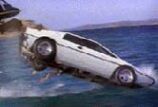 Gadgets: One of the alluring aspects of the Bond character is his endless array of creative gadgets within ordinary items. Some of my favorites include the shaving cream flame thrower (Live and Let Die), the car ejector seat (Goldfinger), the exploding toothpaste (License to Kill), and the underwater Lotus sports car (The Spy Who Loved Me). Gadgets are notably absent from Dr. No, and very few exist in From Russia With Love. After Goldfinger, they were usually, but not always, an integral part of each film.
Gadgets: One of the alluring aspects of the Bond character is his endless array of creative gadgets within ordinary items. Some of my favorites include the shaving cream flame thrower (Live and Let Die), the car ejector seat (Goldfinger), the exploding toothpaste (License to Kill), and the underwater Lotus sports car (The Spy Who Loved Me). Gadgets are notably absent from Dr. No, and very few exist in From Russia With Love. After Goldfinger, they were usually, but not always, an integral part of each film.
 Q: Major Boothroyd (Desmond Llewelyn), known mostly as Q, has worked with all five actors in the series. The master of the Q Branch - the haven for gadgets in the British Secret Service - he's constantly developing new toys for Bond to play with. However, he "never jokes about his work," and is irritated constantly when 007 won't listen to his explanations. Classic scenes involve Bond's visits to Q's headquarters, whose location sometimes rotates around the world. While Q explains Bond's new gadgets, they'll walk past the latest testing equipment, including funny items such as a dinner tray designed to chop off a person's head and a deadly umbrella.
Q: Major Boothroyd (Desmond Llewelyn), known mostly as Q, has worked with all five actors in the series. The master of the Q Branch - the haven for gadgets in the British Secret Service - he's constantly developing new toys for Bond to play with. However, he "never jokes about his work," and is irritated constantly when 007 won't listen to his explanations. Classic scenes involve Bond's visits to Q's headquarters, whose location sometimes rotates around the world. While Q explains Bond's new gadgets, they'll walk past the latest testing equipment, including funny items such as a dinner tray designed to chop off a person's head and a deadly umbrella.
 The Bond girls: Every film usually contains at least two (sometimes more) beautiful girls for Bond to pursue. He generally joins a female colleague on the case, who eventually dies. A variation of this formula is the bad girl who is turned by Bond's charms, then is killed by the main villain. By the end, one of them will stand out as the female lead of the picture. She'll be around for the finale, and will yell the obligatory "James!" so he can save her. This trend has been altered in the more recent films with Timothy Dalton and Pierce Brosnan, where the girl plays a larger role. The actresses that play the Bond girls often are of a VERY LOW acting ability. Some of the recent examples of laugh-inducing acting include Denise Richards (The World is Not Enough) and Talisa Soto (License to Kill).
The Bond girls: Every film usually contains at least two (sometimes more) beautiful girls for Bond to pursue. He generally joins a female colleague on the case, who eventually dies. A variation of this formula is the bad girl who is turned by Bond's charms, then is killed by the main villain. By the end, one of them will stand out as the female lead of the picture. She'll be around for the finale, and will yell the obligatory "James!" so he can save her. This trend has been altered in the more recent films with Timothy Dalton and Pierce Brosnan, where the girl plays a larger role. The actresses that play the Bond girls often are of a VERY LOW acting ability. Some of the recent examples of laugh-inducing acting include Denise Richards (The World is Not Enough) and Talisa Soto (License to Kill).
 Exotic Locales: James Bond is not your typical London cop who searches for clues throughout the dark streets of the city. Instead, he's an international secret agent who travels to all corners of the world to save the day. Part of the allure of the films comes from experiencing new and exotic areas every time. For example, in The Spy Who Loved Me, Bond begins on assignment in the mountains of Austria. He then travels to the pyramids of Egypt and the port of Sardinia before fighting his final battle in Stromberg's ocean home.
Exotic Locales: James Bond is not your typical London cop who searches for clues throughout the dark streets of the city. Instead, he's an international secret agent who travels to all corners of the world to save the day. Part of the allure of the films comes from experiencing new and exotic areas every time. For example, in The Spy Who Loved Me, Bond begins on assignment in the mountains of Austria. He then travels to the pyramids of Egypt and the port of Sardinia before fighting his final battle in Stromberg's ocean home.
 M, Moneypenny, Felix Leiter: These three characters are almost always around to help Bond out on the case. M and Moneypenny work at the MI6 headquarters, while Felix Leiter usually aids him in the field. Moneypenny, played until 1987 by Lois Maxwell, always flirts with Bond, but they never get together. M is his hard-nosed boss, and won't tolerate failure or incompetence. My favorite actor to play M was the stubborn Bernard Lee, but Judi Dench has done a solid job in the last three films. Felix Leiter is almost always a different actor, and Bond never seems to notice. The one exception to this rule is David Hedison, who played Leiter in two films, Live and Let Die and License to Kill.
M, Moneypenny, Felix Leiter: These three characters are almost always around to help Bond out on the case. M and Moneypenny work at the MI6 headquarters, while Felix Leiter usually aids him in the field. Moneypenny, played until 1987 by Lois Maxwell, always flirts with Bond, but they never get together. M is his hard-nosed boss, and won't tolerate failure or incompetence. My favorite actor to play M was the stubborn Bernard Lee, but Judi Dench has done a solid job in the last three films. Felix Leiter is almost always a different actor, and Bond never seems to notice. The one exception to this rule is David Hedison, who played Leiter in two films, Live and Let Die and License to Kill.
Ranking the Films
The continued international success of the Bond franchise makes it difficult to argue with the progression of the series. When screened in movie theaters, the films provide the audience with an entertaining thrill ride. Upon further review, however, only some of the movies remain enjoyable after repeated viewings. Others fall apart amidst their ridiculousness and bad acting. I've watched most of these films numerous times and have developed particular opinions about each one. I did have to go back and screen several movies again because it had been a while. Below is my list of all the Bond films, from best to worst. Since this is just my opinion, I hope to hear responses (positive and negative) about this list. Please contact me at danheaton@coolmail.net with your comments. I look forward to reading them. Without further adieu, here we go:
1. Thunderball (Sean Connery, 1965) This is the quintessential James Bond movie. Now coming into his own in the fourth Bond film, Sean Connery exudes a perfect mix of charm, menace, and wit throughout the story. It features a masterful plan by SPECTRE's #2, Emilio Largo, to steal two nuclear bombs and hold the world hostage. Adolfo Celi plays him as a brutal, hulking man with determination and the utmost confidence in his success. Unlike many of Bond's adversaries, Largo does not sit back like a master tactician and let his plans unfold. Instead, he's out there in the water preparing the missiles and fighting Bond. The stunning Fiona Volpe (Lucianna Paluzzi) is by far the best of the evil Bond girls. He fails to charm her away from SPECTRE, and instead must defeat her with his own wits. Her demise on the dance floor also provides for one of the best lines in the series: "Do you mind if my friend sits this one out? She's just dead." Thunderball also includes several spectacular underwater action scenes and a slam-bang final sequence aboard the yacht/motorboat Disco Valente.
2. License to Kill (Timothy Dalton, 1989) I'm irritated to constantly read criticism of this darker, yet wonderful film. Timothy Dalton comes closest to Ian Fleming's original vision of the character with this tale of Bond's quest for revenge against Franz Sanchez, a vicious drug lord. This story is a refreshing change of pace from the dull last two Roger Moore films, and should have re-invigorated the series. Unfortunately, it failed to connect with the needs of the audience (especially in America) for a silly, light-hearted film. The film does have its supporters, however, and for good reason. Robert Davi gives a surprisingly realistic portrayal of Sanchez, the drug lord who favors loyalty over money. Carey Lowell stands up well with Dalton as tough undercover agent Pam Bouvier, and Desmond Lleywelyn's Q plays a well-deserved larger part in the film. The amazing tanker-truck finale is one of the most explosive (no pun intended) action sequences in the series.
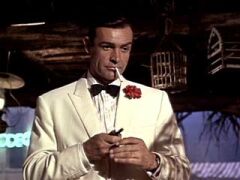 3. Goldfinger (Sean Connery, 1964)
"No Mr. Bond! I expect you to die!" Numerous fans regard this film as the best Bond film, and for good reason. The third entry in the series, it contains all of the elements recognized as standards of any future Bond film. It includes a stunt-filled pre-credits sequence, several beautiful women, a brutal henchman in Oddjob, more gadgets (including the ejector seat), and more sarcastic wit than the first two films. This entry started the progression away from Fleming's vision of the Bond character. But it also became an international sensation, which lead to greater budgets for the successive films. Gert Frobe presents an interesting sight as the hulking Goldfinger, and Shirley Eaton's Jill Masterson is dazzling before her unfortunate gold-induced demise, but Honor Blackman is disappointing as Pussy Galore. I especially enjoy the silent competition of the "friendly" golf game (much more tense in the novel), and the apparently nice old woman who fires the machine gun at Bond as he drives into Goldfinger's facility.
3. Goldfinger (Sean Connery, 1964)
"No Mr. Bond! I expect you to die!" Numerous fans regard this film as the best Bond film, and for good reason. The third entry in the series, it contains all of the elements recognized as standards of any future Bond film. It includes a stunt-filled pre-credits sequence, several beautiful women, a brutal henchman in Oddjob, more gadgets (including the ejector seat), and more sarcastic wit than the first two films. This entry started the progression away from Fleming's vision of the Bond character. But it also became an international sensation, which lead to greater budgets for the successive films. Gert Frobe presents an interesting sight as the hulking Goldfinger, and Shirley Eaton's Jill Masterson is dazzling before her unfortunate gold-induced demise, but Honor Blackman is disappointing as Pussy Galore. I especially enjoy the silent competition of the "friendly" golf game (much more tense in the novel), and the apparently nice old woman who fires the machine gun at Bond as he drives into Goldfinger's facility.
4. The Spy Who Loved Me (Roger Moore, 1977) Arguably the best film of the series in terms of pure fun, this entry features the best attributes of Roger Moore as James Bond. His numerous battles with the steel-toothed Jaws (Richard Kiel) highlight Moore's timely wit and ability to remain unflappable under pressure. Bond faces off with yet another megalomaniac, Carl Stromberg (Curd Jürgens), who plans to destroy the world and create a new world beneath the sea. Even though this film contains numerous recycled plot elements, the action seems fresh and energetic. This is due in part to the chemistry between Moore and Barbara Bach, who plays Russian Major Amasova (Agent XXX). The best Bond girl in the entire series, she matches his moves in every way, yet still remains beautiful and exciting. Also, her plans for revenge toward Bond add extra relevance to the story. Lewis Gilbert (You Only Live Twice and Moonraker) directs the film with an energy missing in Moore's first two efforts. The action is fun, tense, and lively, and barely lets up throughout the story.
5. From Russia With Love (Sean Connery, 1963) While it lacks some of the wit and tongue-in-cheek humor of its successors, this is the best spy thriller in the series. In this, the second Bond film, SPECTRE's goal is not world domination, but just the demise of one man, James Bond. They seek to humiliate him and lure him into a trap with the Lektor machine, a special coding device. The masterminds of this plan are chess champion Kronsteen (Vladek Sheybal) and the devilishly evil Rosa Klebb (Lotte Lenya), and their plans work nearly flawlessly. How will Bond get out of this one? Plus, he must face one of the most formidable villains in the series, Donald "Red" Grant (Robert Shaw), who is trained specifically for killing Bond. While the film's pace is slower, this helps to slowly build the tension towards an exciting climax. Tatiana Romanova, played by 1960's Miss Universe Daniela Bianchi, is one of my favorite Bond girls. I totally understand why Bond would risk his life and possibly enter a trap for her. This story corresponds closely with the Ian Fleming novel with one major exception, the cliffhanger finale. You'll have to read the book to find out what it is.
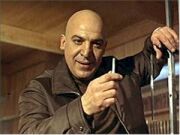 6. On Her Majesty's Secret Service (George Lazenby, 1969)
It is true that George Lazenby fails to reach the level of Sean Connery. But who could follow him and not be disappointing? This film stems from one of my favorite Ian Fleming stories. While once again chasing Blofeld (Telly Savalas), Bond falls in love with the lovely Tracy (Diana Rigg) and they're married near the end of the film. The conclusion is arguably the most emotional and heartbreaking scene in the series. Lazenby doesn't have the smooth toughness of Connery, but he handles the dramatic scenes surprisingly well. Also, the stunts and action sequences remain impressive, especially during Bond's tenacious pursuit of Blofeld on speeding bobsleds. Sevalas transforms Blofeld into a more active force than Donald Pleasence's quirky character in You Only Live Twice. His Blofeld character and Irma Bunt (Ilse Steppat) rank as two of Bond's tougher foes in the series. While this film has its share of wit and silliness, it also contains a refreshing serious tone that disappeared with Connery's return in Diamonds are Forever, a disastrous entry.
6. On Her Majesty's Secret Service (George Lazenby, 1969)
It is true that George Lazenby fails to reach the level of Sean Connery. But who could follow him and not be disappointing? This film stems from one of my favorite Ian Fleming stories. While once again chasing Blofeld (Telly Savalas), Bond falls in love with the lovely Tracy (Diana Rigg) and they're married near the end of the film. The conclusion is arguably the most emotional and heartbreaking scene in the series. Lazenby doesn't have the smooth toughness of Connery, but he handles the dramatic scenes surprisingly well. Also, the stunts and action sequences remain impressive, especially during Bond's tenacious pursuit of Blofeld on speeding bobsleds. Sevalas transforms Blofeld into a more active force than Donald Pleasence's quirky character in You Only Live Twice. His Blofeld character and Irma Bunt (Ilse Steppat) rank as two of Bond's tougher foes in the series. While this film has its share of wit and silliness, it also contains a refreshing serious tone that disappeared with Connery's return in Diamonds are Forever, a disastrous entry.
7. For Your Eyes Only (Roger Moore, 1981) In his fifth Bond film, Roger Moore finally embarks on his first pure spy mission. Following the excesses of Moonraker, first-time Bond director John Glen tried to make Bond more human and add some rough edges to his character. The result is a tense, exciting thriller that contains Moore's strongest acting performance. The story begins with a somber visit to Tracy Bond's grave, which reveals a new side to Moore's character. It's followed by a nerve-wracking helicopter ride and a brief re-appearance by Blofeld. Both of these scenes show recognition by writers Richard Maibaum and Michael G. Wilson of the past events in the series. The prime story focuses on Bond's attempts to discover who is trying to sell the ATAC, a missile-guidance system, to the Russians. His search for clues requires more ingenuity and fewer gadgets than usual. Also, the identity of the major villain is unknown for the first hour. Is it the suave smuggler Colombo (Topol) or the strangely helpful Kristatos (Julian Glover)? Added to the mix is Melina (Caroline Bouquet), a gorgeous young woman who wants revenge against whoever killed her parents. The action scenes remain top-notch, and include two of the best in the series. A wonderful skiing sequence culminates in a breathtaking race between Bond and several motorcycles down an active bobsled track. Bond's climb (and near-fall) from a sheer, rocky cliff in the film's finale is arguably the most hair-raising scene in any of Moore's seven films. For Your Eyes Only is also noteworthy for the scene where Moore kills a henchman in cold blood. Reportedly criticized by Moore for going against his persona, it showcases his surprising believability in playing the vicious killer of Fleming's novels.
8. Dr. No (Sean Connery, 1962) Here is the film that started it all, with a young Sean Connery battling the menacing and evil Dr. No (Joseph Wiseman). This film lacks the usual pre-credits action sequence, gadgets, and one-liners, but it shows Bond using his wits to survive. This version of Bond is more ruthless, and even has him shooting a man in the back. This gives the story more weight and tension than in some of the later films. While it is a little slow, and Connery is still shaping the role, this film contains numerous memorable moments. The obvious one is Ursula Andress rising out of the water (recently spoofed in Austin Powers: The Spy Who Shagged Me). Bond's encounter with a tarantula (a centipede in the book) is particularly chilling, and the fire-breathing "dragon" is an interesting creation. My favorite part is the final act, when Dr. No falls prey to what Roger Ebert calls "The Fallacy of the Talking Killer." Instead of killing Bond, he dines with him and tells him his plans, and you know where that will lead him.
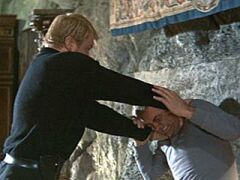 9. You Only Live Twice (Sean Connery, 1967)
Bond journeys to Japan to face Blofeld (Donald Pleasence of the Halloween films) in the last of the classic Connery films. SPECTRE has designed a ship that is able to capture American and Russian craft in space. Both superpowers blame each other for the disappearances, and this could lead to nuclear war. Bond must step in and save the day. He teams up with Japanese agent Tiger Tanaka (Tetsuro Tamba) to discover the source of the disappearance. This leads to my favorite enemy fortress, the base hidden beneath an apparent volcano. This film contains the first direct sighting of Blofeld's face. Pleasence, with a strange scar across one eye, is one of the oddest-looking villains in the series. Dr. Evil from the Austin Powers movies seems to mostly resemble this version of Blofeld. While the story is mediocre, the action scenes are the real drawing point, with the highlight being the final attack on the volcano. The pace drags a bit in the middle scenes, especially with Bond becoming disguised as a Japanese man. Although it is a peculiar film, Connery truly shines as Bond for the final time in this film.
9. You Only Live Twice (Sean Connery, 1967)
Bond journeys to Japan to face Blofeld (Donald Pleasence of the Halloween films) in the last of the classic Connery films. SPECTRE has designed a ship that is able to capture American and Russian craft in space. Both superpowers blame each other for the disappearances, and this could lead to nuclear war. Bond must step in and save the day. He teams up with Japanese agent Tiger Tanaka (Tetsuro Tamba) to discover the source of the disappearance. This leads to my favorite enemy fortress, the base hidden beneath an apparent volcano. This film contains the first direct sighting of Blofeld's face. Pleasence, with a strange scar across one eye, is one of the oddest-looking villains in the series. Dr. Evil from the Austin Powers movies seems to mostly resemble this version of Blofeld. While the story is mediocre, the action scenes are the real drawing point, with the highlight being the final attack on the volcano. The pace drags a bit in the middle scenes, especially with Bond becoming disguised as a Japanese man. Although it is a peculiar film, Connery truly shines as Bond for the final time in this film.
10. The World is Not Enough (Pierce Brosnan, 1999) In his third outing, Pierce Brosnan finally gets it right with this exciting stunt-filled epic. The highlight is the surprisingly lengthy pre-credits sequence, where Bond embarks on a high-speed chase after a mysterious assassin. With each successive film, Brosnan is creating a colder persona for his character, and this adds to the intrigue. He also takes a beating in this film, which makes him appear more human and vulnerable than in his first two films. Sophie Marceau gives an attractive performance as Elektra King, a supposed "damsel in distress" with more lurking beneath the surface. The main villain Renard (Robert Carlyle of The Full Monty) remains off-screen for a long time, and it adds to his mysterious subtlety. Director Michael Apted keeps the action moving at an energetic pace, but unfortunately the film falls apart in its last act. This isn't entirely his fault, though, as the story suffers from two major problems: striking Denise Richards' terrible acting as a nuclear scientist and the unnecessary and dull submarine finale. Still, the first 90 minutes of this film work amazingly well and provide hope for "Bond 20" in 2002.
11. Live and Let Die (Roger Moore, 1973) The Roger Moore era began solidly with this quirky entry in the series. The tone of the story reflects the '70s era, with gaudier costumes, locations, and music. Yaphet Kotto (Lt. Giardello from Homicide) gives a forceful performance as drug lord Mr. Big/Kananga, and it's unfortunate that the final showdown is so ridiculous. Jane Seymour (in her first film role) is average as Solitaire, a woman with the power to predict the future. Sadly, this film suffers from its poor stereotypical portrayal of African-American culture. However, there are still some elements to like in this movie. Moore steps into the role nicely with a decent performance, and the theme song by Paul Mccartney is one of the best in the series. The speedboat chase through the Louisiana Bayou is an exciting highlight.
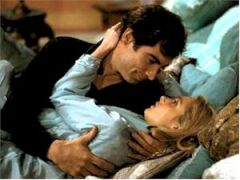 12. The Living Daylights (Timothy Dalton, 1987)
Timothy Dalton's first film injected new life into a dying series. His persona was a welcome change after the two preceding dull Roger Moore films. While the tone still touches the lighthearted flair of Moore's character, the focus now is on a more serious, modern secret agent. Except for an implied liaison in the teaser, Bond's heralded promiscuity barely registers, with his focus staying on just one woman, Russian Kara Milovy (Maryam d'Abo). This allows for a more intricate plot than its recent predecessors, and gives Dalton a chance to do more than spout wisecracks in the midst of countless explosions. Unfortunately, the story struggles through several flat scenes and nearly collapses under the weight of two lackluster villains. Quirky smuggler Brad Whitaker (Joe Don Baker) fails to emanate any danger towards Bond, and Russian defector Georgi Koskov (Jeroen Krabbé) never really establishes himself as more than a pushover. However, The Living Daylights stands as a competent entry in the series because it moves towards a modern version of Ian Fleming's character that would work perfectly in License to Kill.
12. The Living Daylights (Timothy Dalton, 1987)
Timothy Dalton's first film injected new life into a dying series. His persona was a welcome change after the two preceding dull Roger Moore films. While the tone still touches the lighthearted flair of Moore's character, the focus now is on a more serious, modern secret agent. Except for an implied liaison in the teaser, Bond's heralded promiscuity barely registers, with his focus staying on just one woman, Russian Kara Milovy (Maryam d'Abo). This allows for a more intricate plot than its recent predecessors, and gives Dalton a chance to do more than spout wisecracks in the midst of countless explosions. Unfortunately, the story struggles through several flat scenes and nearly collapses under the weight of two lackluster villains. Quirky smuggler Brad Whitaker (Joe Don Baker) fails to emanate any danger towards Bond, and Russian defector Georgi Koskov (Jeroen Krabbé) never really establishes himself as more than a pushover. However, The Living Daylights stands as a competent entry in the series because it moves towards a modern version of Ian Fleming's character that would work perfectly in License to Kill.
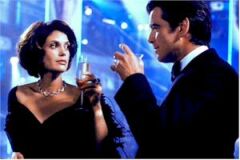 13. Tomorrow Never Dies (Pierce Brosnan, 1997)
I really enjoyed this film in the movie theaters, especially Jonathan Pryce's silly performance as Elliot Carver and the numerous extended action sequences. Michelle Yeoh (Supercop) really kicks butt as the Bond girl, and it's refreshing to see her save Bond a few times. Everything in this film, from the motorcycle chase to the submarine finale, is extremely over-the-top. My favorite scene involves Bond's newly modified BMW, which he uses by remote control to fight Carver's unsuspecting henchmen. An interesting subplot is Bond's relationship with Paris Carver (Teri Hatcher), a past love that didn't work out. For some reason, however, this film really suffered on the second viewing. I found the action scenes tedious and overlong, and the events appeared more ridiculous than before. Also, the whole film seemed long and overdone. Still, it's an improvement over Goldeneye, and contains plenty of eye candy throughout.
13. Tomorrow Never Dies (Pierce Brosnan, 1997)
I really enjoyed this film in the movie theaters, especially Jonathan Pryce's silly performance as Elliot Carver and the numerous extended action sequences. Michelle Yeoh (Supercop) really kicks butt as the Bond girl, and it's refreshing to see her save Bond a few times. Everything in this film, from the motorcycle chase to the submarine finale, is extremely over-the-top. My favorite scene involves Bond's newly modified BMW, which he uses by remote control to fight Carver's unsuspecting henchmen. An interesting subplot is Bond's relationship with Paris Carver (Teri Hatcher), a past love that didn't work out. For some reason, however, this film really suffered on the second viewing. I found the action scenes tedious and overlong, and the events appeared more ridiculous than before. Also, the whole film seemed long and overdone. Still, it's an improvement over Goldeneye, and contains plenty of eye candy throughout.
14. Goldeneye (Pierce Brosnan, 1995) This film was similar to Tomorrow Never Dies in that I liked it less with each viewing. At the time of its release in 1995, it was the first Bond film in six years, and everything felt fresh again. For audiences turned off by Dalton's seriousness, Brosnan brought fun to the role again. He combined the wittiness of Roger Moore with the smooth touch of Sean Connery. Upon closer inspection, however, too many scenes in this film are just downright ridiculous, even for Bond. This is especially evident in the pre-credits sequence, where Bond free-falls next to a plane, stops by the door, and lifts it over a mountain. This is James Bond playing superman. I like the idea of him facing former partner Alex Trevalyn (Sean Bean), who should know how to defeat Bond. Instead, he falls prey to the same mistakes that nearly all Bond villains make. Xenia Onatopp (Famke Janssen) is an inventive Bond girl, and Janssen brings loads of energy to the role. Goldeneye provides a good time, but needs a little more substance to rank with the better Bond films.
15. The Man With the Golden Gun (Roger Moore, 1974) Ian Fleming's novel contained a tense and intriguing battle of wills between two killers, Bond and Francisco Scaramanga. Nearly killed in his last mission and then brainwashed by the Russians, Bond is sent on a nearly impossible mission by M. Scaramanga is one of the deadliest and most ruthless men ever to face off against him. Unfortunately, Roger Moore's second film fails to come even close to the level of the novel. Instead, we get a goofy film starring Christopher Lee as Scaramanga and Hervé Villechaize as Nick Nack, one of the weakest henchmen in the series. Lee does a good acting job, but his villain never reaches the level of ruthlessness necessary for his character. But it's not his fault, as this film is so silly that Fleming's evil killer couldn't exist here. There are some entertaining moments, including the scenes in the deadly funhouse on Scaramanga's island. This was one of the best parts of any Bond film for me as a kid. There's not much else to like in this film, except perhaps the 360-degree car jump across the bridge. Even though it hardly compares to the novel, the confrontation between Lee and Moore is interesting enough to make this film better than the worst entries in the series.
16. Never Say Never Again (Sean Connery, 1983) Sony's remake of Thunderball sounds great on paper, but unfortunately fails to capture the essence of the original. Surprisingly, Sean Connery decided to return for this role, and without him this movie would stink. While looking a little too old for the part, Connery still injects some fun into the role. Klaus Maria Brandauer's Largo provides a worthy adversary for Bond, but their computerized world domination battle is the only notable conflict between them. That scene is a tense battle of wills that is threatening without the usual deadly weapons. Brandauer makes Largo human, with flaws, and it's an interesting portrayal, but the film's execution doesn't match up to his acting. Kim Bassinger is a terrible choice for Domino, and her pairing with Connery just doesn't work. Even with a larger budget, the conclusion can't match the intensity of the original's underwater scenes. Because of Connery's return, this film is an intriguing failure.
 17. Moonraker (Roger Moore, 1979)
"His name is Jaws; he kills people." The return of Jaws is by far the best part of this ridiculous space adventure for Bond. After the success of Star Wars, this was an attempt by the producers to cash in on the space craze. Unfortunately, this film becomes pure camp with ridiculous action sequences on earth and in space. The villain, Hugo Drax (Michael Lonsdale), is dull and lacks any interesting character traits. He is simply a variation of The Spy Who Loved Me's Stromberg, who was a decent villain but nothing spectacular. The only energy comes from Bond's fights with Jaws, especially on a jungle river and an aerial cable car. Unfortunately, the hulking villain's personality change at the end is too silly to be believable. The action scenes in space, with the silly laser lights, are uninteresting and unintentionally funny. I would have rated this film a few spots lower, but it was one of my favorite Bond films as a kid.
17. Moonraker (Roger Moore, 1979)
"His name is Jaws; he kills people." The return of Jaws is by far the best part of this ridiculous space adventure for Bond. After the success of Star Wars, this was an attempt by the producers to cash in on the space craze. Unfortunately, this film becomes pure camp with ridiculous action sequences on earth and in space. The villain, Hugo Drax (Michael Lonsdale), is dull and lacks any interesting character traits. He is simply a variation of The Spy Who Loved Me's Stromberg, who was a decent villain but nothing spectacular. The only energy comes from Bond's fights with Jaws, especially on a jungle river and an aerial cable car. Unfortunately, the hulking villain's personality change at the end is too silly to be believable. The action scenes in space, with the silly laser lights, are uninteresting and unintentionally funny. I would have rated this film a few spots lower, but it was one of my favorite Bond films as a kid.
18. Octopussy (Roger Moore, 1983) It's unfortunate that Roger Moore didn't step down after For Your Eyes Only, a hard-nosed and exciting film. Instead, we have this silly entry that tries way too hard to entertain. The story involves smuggling of prized jewels and a possible nuclear explosion. A Russian general, Orlov (Stephen Berkoff) plans to restart the Cold War by setting off a bomb at an American facility. He's teamed up with Kamal (Louis Jourdan), the central villain of the piece, to execute a complex plan. In the middle is Octopussy (Maud Adams), an attractive smuggler who Bond needs to defeat Kamal's plan. A grand era in the Bond series could have originated if the writers followed the trends set in the previous film. Why did they choose to make this ridiculous movie? The convoluted nature of the plot doesn't bother me nearly as much as the absurd set pieces. Sequences obviously designed for a laugh include Bond as Tarzan, a clown, and a mechanical crocodile. I have nothing against inventiveness, but it has to have at least a slight element of believability. I give Roger Moore credit for giving this story his best shot. It makes this film better (although only slightly) than its successor, A View to a Kill.
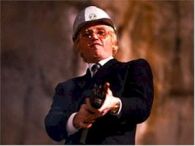 19. A View to a Kill (Roger Moore, 1985)
Christopher Walken would appear to be the perfect choice for a Bond villain. He can exude evil in almost any setting, and chews up scenes better than almost anyone. However, Max Zorin is not the character needed to display Walken's abilities. This man is crazy, with his bright blond hair and silly laugh, but he never really clicks as a classic villain. Also, Roger Moore looks far too old here to play James Bond. The filmmakers should have done a better job disguising this fact (see #20 for more on this). Also, Grace Jones seems like an odd choice to play a Bond girl. She's not the worst actress in this movie, however. That title goes to Tanya Roberts, a former Charlie's Angel, who laughably plays Stacy Sutton. Never has the "Oh James!" line sounded more dated and ridiculous. The few positives of this film occur at the beginning and the end. The opening skiing sequence (yes, another one) still works, even when Moore surfs across the water with the Beach Boys playing in the background. The finale on the Golden Gate Bridge is so utterly ridiculous that it's enjoyable.
19. A View to a Kill (Roger Moore, 1985)
Christopher Walken would appear to be the perfect choice for a Bond villain. He can exude evil in almost any setting, and chews up scenes better than almost anyone. However, Max Zorin is not the character needed to display Walken's abilities. This man is crazy, with his bright blond hair and silly laugh, but he never really clicks as a classic villain. Also, Roger Moore looks far too old here to play James Bond. The filmmakers should have done a better job disguising this fact (see #20 for more on this). Also, Grace Jones seems like an odd choice to play a Bond girl. She's not the worst actress in this movie, however. That title goes to Tanya Roberts, a former Charlie's Angel, who laughably plays Stacy Sutton. Never has the "Oh James!" line sounded more dated and ridiculous. The few positives of this film occur at the beginning and the end. The opening skiing sequence (yes, another one) still works, even when Moore surfs across the water with the Beach Boys playing in the background. The finale on the Golden Gate Bridge is so utterly ridiculous that it's enjoyable.
20. Diamonds are Forever (Sean Connery, 1971) Sean Connery should have quit after You Only Live Twice. Only four years later, why does he look about 20 years older? He needed a better wig for this picture to cover up his age. James Bond cannot believably climb up buildings and flirt with young girls when he looks this bad. If this wasn't enough, Connery also looks out of place within the numerous silly sequences. The moon buggy scene across the desert and his fight in the pool with the two athletic young girls just don't work. Plus, Mr. Wint (Bruce Glover) and Mr. Kidd (Putter Smith), the main henchmen, just don't generate enough menace or interest. I don't think any actor could have really saved this picture. It's too bad that they had to waste Blofeld's last leading role with this piece of junk.
The Future?
Moviegoers will have to wait an extra year for the return of Pierce Brosnan as James Bond. Very little is known about the plot at this time, but I'm fairly certain it will be another financial success. But where can the Bond films go from here? Should Brosnan kill the character off in a final heroic act? Several times in the past, the series appeared to be nearing its end. Each time, a new actor stepped up and resurrected the character to a new level (most notably Brosnan). But how many different actors can play James Bond before audiences tire of the conventions of the story? In The World Is Not Enough, the creators used the same formula, but kept the story fresh with some innovative storytelling. For the Bond series to survive, they must take the story even further and avoid the urge to go on autopilot. This dull similarity nearly killed the series creatively during the later Roger Moore years. Brosnan plans to only do one more Bond film, and I doubt it will be the last one. A new actor will probably take the reins and lead the series into the 21st century. Will the stories still be interesting? We'll see. I still have my fingers crossed for a true adaptation of Casino Royale someday.
(Note: Even if you've seen the Bond films countless times, check out the recent Special Edition DVDs. The documentaries, artwork, and commentaries provide a fascinating background for each film, and the audio and video quality is amazing.)
Copyright (c) 2005 erasing clouds |
|